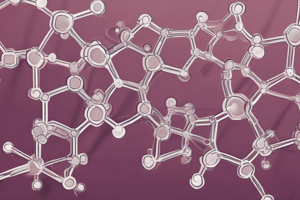Podcast
Questions and Answers
What is the reason for the difference in chemical reactivity of benzene?
What is the reason for the difference in chemical reactivity of benzene?
- The number of carbon atoms in benzene
- The presence of hydrogen atoms in benzene
- The presence of double bonds in benzene
- The structure of benzene (correct)
How are monosubstituted benzenes named according to IUPAC?
How are monosubstituted benzenes named according to IUPAC?
- By placing the name of the group as suffix to the benzene
- By placing the name of the group as prefix to the benzene (correct)
- By placing the name of the group at the end of the benzene
- By placing the name of the group in the middle of the benzene
What is the origin of the term 'aromatic' in aromatic compounds?
What is the origin of the term 'aromatic' in aromatic compounds?
- From the French word for 'unsaturated compounds'
- From the Greek word for 'fragrant smell' (correct)
- From the Latin word for 'chemical behavior'
- From the Arabic word for 'distinctive odor'
What is the term for the position of two substituents on a benzene ring that are separated by two carbons?
What is the term for the position of two substituents on a benzene ring that are separated by two carbons?
What is the characteristic of the C-C bonds in benzene?
What is the characteristic of the C-C bonds in benzene?
What are the four conditions necessary for a compound to be classified as aromatic?
What are the four conditions necessary for a compound to be classified as aromatic?
What is the formula for determining the aromatic quality of a planar ring-shaped molecule?
What is the formula for determining the aromatic quality of a planar ring-shaped molecule?
What is the reason for the stability of benzene?
What is the reason for the stability of benzene?
What is the result if a molecule does not follow the 4n+2 rule?
What is the result if a molecule does not follow the 4n+2 rule?
What type of reaction does benzene undergo with Br2?
What type of reaction does benzene undergo with Br2?
What is the characteristic of the electron density in all six C-C bonds of benzene?
What is the characteristic of the electron density in all six C-C bonds of benzene?
What are the two categories of aromatic compounds?
What are the two categories of aromatic compounds?
What is a characteristic of benzene?
What is a characteristic of benzene?
What type of reactions do aromatic compounds undergo?
What type of reactions do aromatic compounds undergo?
Under what conditions does benzene react?
Under what conditions does benzene react?
What is an example of a non-benzenoid aromatic compound?
What is an example of a non-benzenoid aromatic compound?
Flashcards are hidden until you start studying
Study Notes
Introduction to Aromatic Compounds
- Aromatic compounds are named after the Greek word "aroma", meaning fragrant smell, due to the distinctive odors of many of these compounds.
- The term "aromatic" refers to compounds structurally related to benzene.
- Four conditions must be satisfied for a compound to be aromatic:
- Cyclic
- Planar
- Conjugated
- Obeying Hückel's Rule
Hückel's Rule
- Hückel's Rule estimates the aromatic qualities of a planar ring-shaped molecule.
- The molecule must have 4n+2 π-electrons, where n is an integer (0, 1, 2, 3, ...).
- Molecules that don't follow the 4n+2 rule are called non-aromatic.
Classification of Aromatic Compounds
- Aromatic compounds are broadly divided into two categories:
- Benzenoids (containing a benzene ring)
- Non-benzenoids (not containing a benzene ring, e.g., furan)
Benzene
- Benzene has a high degree of unsaturation but is unreactive.
- It does not undergo the usual addition reactions of alkenes and alkynes.
- It reacts under more vigorous conditions (heat or catalysts) to form products of substitution.
- Benzene is represented as a six-carbon ring with 3 double bonds.
- Two possible isomers can be drawn to show benzene in this form.
Naming Aromatic Compounds
- Aromatic compounds are named according to IUPAC rules.
- When one group is attached to benzene, the compound is named by placing the group name as a prefix to benzene.
- Monosubstituted benzenes are systematically named with benzene as the parent name and the substituent is indicated by a prefix.
- Many common names have been accepted by IUPAC, e.g., toluene (methylbenzene), phenol (hydroxybenzene), and aniline (aminobenzene).
Disubstituted Benzenes
- Relative positions on a disubstituted benzene ring:
- Ortho- (o) on adjacent carbons (1,2 disubstituted)
- Meta- (m) separated by one carbon (1,3 disubstituted)
- Para- (p) separated by two carbons (1,4 disubstituted)
- The ortho-, meta-, and para- nomenclature is useful to describe reaction patterns.
Multisubstituted Benzenes
- Multisubstituted benzenes are named by:
- Choosing the sequence when the substituents have the lowest possible number
- Listing substituents alphabetically with hyphenated numbers
- Using common names as parent names
Structure and Stability of Benzene
- Benzene is very stable and undergoes substitution rather than addition reactions.
- It has a higher barrier to reaction due to its unusual structure.
- All C-C bonds in benzene are the same length, with identical electron density.
- The structure is planar, hexagonal, with 120° C-C-C bond angles.
- Benzene has 6 delocalized p electrons over the ring.
Reactions of Benzene
- Even though benzene is highly unsaturated, it does not undergo regular reactions of alkenes, such as addition or oxidation.
- Benzene reacts slowly with Br2 to give bromobenzene (where Br replaces H).
Substitution Reactions of Aromatic Compounds
- Substitution reactions involve the replacement of a hydrogen atom on the benzene ring with another group, such as chlorine, methyl, acetyl, nitric acid, or sulfuric acid.
Studying That Suits You
Use AI to generate personalized quizzes and flashcards to suit your learning preferences.




